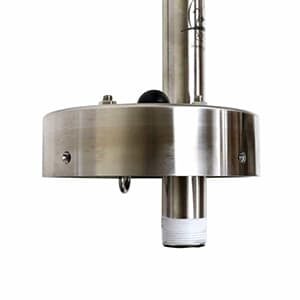In this section we are going to discuss the details of how a Side-By-Side Deep Well Pump System works.
Highlights of Side-By-Side Deep Well Pump System
- Well has a Static Water Level up to 250 feet.
- Pump system must be mounted directly above the well.
- Typically cannot be used on water sources other than wells though we have used them on deep tanks.
- Water is lifted through this system which allows it to bring up water from 250 feet below the surface (300 feet with Heavy Duty Pump Head and Handle option).
- Drop Pipe and cylinder sizes are determined based on static water level and choke point distance primarily.
- Moving the handle up/down actuates the piston assembly inside the cylinder which lifts the water.
- Must use rigid pipe that has drop rod inside. Therefore, you cannot use flexible pipe or the electric submersible pump’s pipe. The deep well pump system must have its own drop pipe system.
- Cylinders are typically placed 20 feet below the static water level.
- Deep well systems are in the same well casing as an electric submersible pump installed “side-by-side”.
Details
A Side-By-Side Deep Well Pump System is a Lift Pump that is installed inside the same well casing as an electric submersible pump system. View diagram of a side-by-side deep well pump system. This means that the well casing’s inside diameter (Well Casing Measuring) must be large enough to accommodate both systems at the same time. Typically, this means that the well casing must be 5” or greater to utilize this system. There are other factors that impact the design.
How we determine which style of pump head to recommend

Standard Deep Well Pump Adapter
The pump head is the device that you see above ground. Our primary objective is determining how to connect the pump head to the well. Most wells are cased and use the Standard Well Pump Adapter. For these systems, the outside diameter of the well casing is required so that we can properly size the well pump adapter. There are many applications that require other methods to connect the pump head to the well. You can review them here Side-By-Side or Standalone Deep Well Pump Systems.
For the Standard and Submersible Connection Well Pump Adapters, the next required measurement is the well casing inside diameter. That is the measurement used to size the gasket which creates the well seal. This measurement is critical because an error could result in the gasket not fitting into the well casing. If the gasket is too small, it will not seal.
How we determine the size of pipe to recommend
In situations where the static water level is less than 160 feet, we typically recommend the 1 1/4” NPT pipe in 8-foot lengths. This pipe has a built-in bell housing that measures 2.125 inches in diameter. Therefore, this is the least amount of space required inside your well casing in order to use this drop pipe and rod. For wells with static water levels beyond 160 feet, we use 1” NPT drop pipe and rod, which has a bell diameter of 1.77 inches. The smaller pipe diameter reduces the head pressure, which thereby reduces the amount of force required on the handle to pump the cylinder. Typically the Choke Point in the well casing where the pitless adapter is located. Once you have determined the Choke Point size we will know if we can use the drop pipe recommended for your static water level or if we must reduce the size to accommodate this measurement.
How we determine the size of cylinder to recommend
Cylinders come in four sizes: 1,5”, 2”, 2.5” and 3” diameter. The water output per stroke decreases as the diameter of the cylinder decreases. As the static water level increases (gets deeper), the difficulty of lifting the water by pumping the handle increases. Therefore, we reduce the recommended cylinder size as the static water level gets deeper. We use this Standard Cylinder Selection Chart as a guide. The green area represents the recommended size of the cylinder at each static water level. The size of the cylinder recommended for your system is determined by two factors: static water level and the distance available at the Choke Point discussed above. Knowing these two factors, we can size the appropriate cylinder for each well to achieve the maximum water output.
How do we determine where to place your cylinder
Cylinders are placed approximately 20 feet below the static water level. Customers often want to place their cylinder deeper into the well. We normally do not recommend this unless there are contributing factors such as a static water level that fluctuates more than 20 feet, or if better water quality is at a lower level. Some customers just want a larger amount of water from the “storage” of a column of water. These changes to the system normally do not impact the function of the pump system if the extra depth isn’t too great. The pressure on the handle will only increase by the additional weight of the 3/8” stainless steel drop rods. It will add more cost to the system to add additional sections of drop pipe and rod. One approach to help with this request is to add up to three sections of drop pipe only to the bottom of the cylinder. The cylinder can draw water from up to 25 feet below its mounting location. Therefore, it can draw water 24 feet (three sections of 8-foot drop pipe) below it, without adding extra weight from the rods.
If by going 20 feet below the static water level, we are less than 5 to 8 feet from the bottom of the well, we will recommend one of two approaches. One is to reduce the depth of the cylinder to be at least 8 to 10 feet from the bottom. This is because of the potential for silt and other debris to enter the cylinder water inlet. If the customer is confident that this is not a concern, then we may leave it at that depth. We also consider fluctuations in the water table that may put the cylinder out of the water. Another option is to add a Silt Screen to the bottom of the cylinder. This is a fine Stainless Steel Cylinder Silt Screen that helps prevent silt from entering the pump system. Over time, silt can build up on the check valve causing it to remain open. This prevents the piston from being able to “load” properly. Eventually the pump will fail due to the buildup requiring replacement of the check valve.
Interactions with existing electric submersible pump
The Bison Pump Side-By-Side Deep Well Pump System is designed primarily to occupy one side of the well casing while an electric submersible pump system would be on the other side. This approach works as long as the inside diameter of the well casing is large enough to accommodate both the electric submersible pump pipe and the Bison Pump pipe or cylinder, whichever is the largest. When an electric submersible pump’s water output is through the well cap, then we must accommodate that pipe connection in the well pump adapter. Aside from the connection of the electric pump’s pipe to the bottom nipple and the top elbow, the rest of the operation of the pump system is the same as described above.
Considerations
- When the well is not deep enough, placing the Bison cylinder 20 feet below the static water level can put it near the electric submersible pump. The movement of the electric pump during startup can cause issues if the two systems are too close. Therefore, we try to maintain a 10’ distance between the two pumps. We must adjust the cylinder placement accordingly. However, the cylinder must always be in the water, or the pump could run dry. In some of these cases, we will recommend adding drop pipe below the cylinder to provide more water to be accessible to the water inlet.
- Well casing height above the ground is recommended to be 12 inches to 18 inches. This height will place the pump handle in a comfortable pumping height.
- If the well casing is PVC, the wall thickness can become an issue. Evaluate the strength of your well casing at the recommended height. Often, we find that customers need to provide some type of support for their PVC well casing when the wall thickness is thin.

